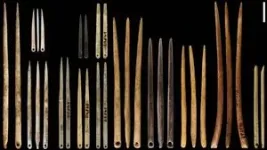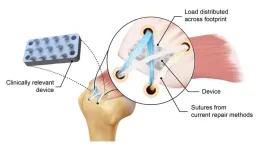Deep learning-assisted lesion segmentation in PET/CT imaging: A feasibility study for salvage radiation therapy in prostate cancer
2024-06-28
(Press-News.org)
“The deployment of DL segmentation methods in 18F-fluciclovine PET/CT imaging represents an intriguing research direction for precision medicine in salvage prostate cancer care.”
BUFFALO, NY- June 28, 2024 – A new editorial paper was published in Oncoscience (Volume 11) on May 20, 2024, entitled, “Deep learning-assisted lesion segmentation in PET/CT imaging: A feasibility study for salvage radiation therapy in prostate cancer.”
In this new editorial, researchers Richard L.J. Qiu, Chih-Wei Chang, and Xiaofeng Yang from Emory University discuss prostate cancer. Prostate cancer persists as the most frequently diagnosed malignancy in men beyond skin cancer. Despite substantial advancements in treatment outcomes over the past half century, progression or recurrence post-initial treatments like prostatectomy or radiation therapy remains a challenge for a subset of patients.
“In those scenarios, salvage radiation therapy is often offered to patients as a treatment option. To design the salvage radiation therapy, imaging is required to detect and locate the recurrence disease regime.”
Traditional imaging modalities employed post-prostatectomy, such as CT, bone scans, MRI or 18F-FDG PET, often fall short in accurately detecting and determining the volume of the recurrent disease, which is crucial for salvage radiation treatment planning. However, the introduction of 18F-fluciclovine (anti-1-amino-3-18F-fluorocyclobutane-1-carboxylic acid) PET/CT has marked a significant advancement in salvage disease management. Recent studies, including the phase 2/3 randomized controlled trial, Emory Molecular Prostate Imaging for Radiotherapy Enhancement (EMPIRE-1), demonstrated improved biochemical recurrence or persistence free survival rates when incorporating 18F-fluciclovine PET/CT into post-prostatectomy radiation therapy planning.
One key step in salvage radiation therapy planning is the delineation of lesions on the 18F-fluciclovine PET/CT images, a task currently undertaken manually by physicians. This practice, while meticulous, is labor-intensive and prone to inter- and intra-observer variations. With the recent explosion of using artificial intelligence (AI) algorithms in medical image processing, automatic segmentation of lesions using deep learning (DL)-based lesion delineation methods demonstrate promising potential to improve treatment quality, as opposed to manual contouring.
“This editorial explores the research study by Wang et al. [4], showcasing the feasibility of DL models in lesion segmentation on 18F-fluciclovine PET/CT images.”
Continue reading: DOI: https://doi.org/10.18632/oncoscience.603
Correspondence to: Richard L.J. Qiu
Email: lei.qiu@emory.edu
Keywords: PSMA PET/CT, deep learning, auto-segmentation, radiation oncology, prostate cancer
About Oncoscience:
Oncoscience is a peer-reviewed, open-access, traditional journal covering the rapidly growing field of cancer research, especially emergent topics not currently covered by other journals. This journal has a special mission: Freeing oncology from publication cost. It is free for the readers and the authors.
Oncoscience is indexed and archived by PubMed, PubMed Central, Scopus, META (Chan Zuckerberg Initiative) (2018-2022), and Dimensions (Digital Science).
To learn more about Oncoscience, visit Oncoscience.us and connect with us on social media:
X, formerly Twitter
Instagram
Facebook
YouTube
LinkedIn
For media inquiries, please contact media@impactjournals.com.
Oncoscience Journal Office
6666 East Quaker Str., Suite 1D
Orchard Park, NY 14127
Phone: 1-800-922-0957, option 4
###
END
ELSE PRESS RELEASES FROM THIS DATE:
2024-06-28
An A-list of researchers from across USC is building a dementia cost model that will generate comprehensive national, annual estimates of the cost of dementia that could benefit patients and their families, thanks to a five-year, $8.2 million federal grant from the National Institute on Aging.
A firm grip on the costs of the disease could assist families living with dementia with planning their budgets and support needs, inform treatment and caregiving options, and help shape health care policy.
“We currently have estimates for a particular ...
2024-06-28
TAMPA, Fla. — Withanolides, a class of naturally occurring compounds found in plants, have long been a focus of cancer research due to their ability to inhibit cancer cell growth, induce cell death and prevent metastasis. These compounds are important in developing new cancer treatments. However, the difficulty of obtaining enough of these compounds from plants has hindered research and therapeutic development.
Moffitt Cancer Center researchers have developed a groundbreaking method for the scalable synthesis of withanolides. This innovative approach, published in Science Advances, could revolutionize cancer research by providing ...
2024-06-28
PROVIDENCE, R.I. [Brown University] — NASA’s Mars InSight Lander may be resting on the Red Planet in retirement, but data from the robotic explorer is still leading to seismic discoveries on Earth.
In one of the latest studies using data from the spacecraft, an international team of scientists led by a Brown University researcher found that Mars may be getting bombarded by space rocks at more frequent rates than previously thought. Impact rates could be two to 10 times higher than previously estimated, depending on the size of the meteoroids, according to the study published in Science Advances.
“It’s ...
2024-06-28
Researchers at Baylor College of Medicine, the University of Cambridge in the U.K. and collaborating institutions have shown that serotonin 2C receptor in the brain regulates memory in people and animal models. The findings, published in the journal Science Advances, not only provide new insights into the factors involved in healthy memory but also in conditions associated with memory loss, like Alzheimer’s disease, and suggest novel avenues for treatment.
“Serotonin, a compound produced by neurons in the midbrain, acts as a neurotransmitter, passing messages between brain cells,” said co-corresponding author Dr. Yong Xu, professor of pediatrics ...
2024-06-28
New York, NY—June 24, 2024—Most people, when they think about pythons, visualize the huge snake constricting and swallowing victims whole. But did you know that pythons initially hold onto their prey with their sharp, backward-curving teeth? Medical researchers have long been aware that these teeth are perfect for grasping soft tissue rather than cutting through it, but no one has yet been able to put this concept into surgical practice. Over the years, mimicking these teeth for use in surgery has been a frequent topic ...
2024-06-28
EMBARGO: 4:00 Sydney AEST June 29 | 14:00 US ET June 28 2024
The beginnings of fashion
Paleolithic eyed needles and the evolution of dress
A team of researchers led by an archaeologist at the University of Sydney are the first to suggest that eyed needles were a new technological innovation used to adorn clothing for social and cultural purposes, marking the major shift from clothes as protection to clothes as an expression of identity.
“Eyed needle tools are an important development in prehistory because they document a transition in the function of clothing from utilitarian to social purposes,” says Dr Ian Gilligan, Honorary Associate ...
2024-06-28
FRANKFURT. In congratulating the CARISMa scientists, Goethe University President Prof. Enrico Schleiff said: “The new LOEWE network sets up in Hesse an innovative research program that is currently gathering steam all over the world. It also expands Goethe University’s existing research profile and broadens our network of cooperation partners in the field of CAR cell therapy [editor’s note: CAR is the abbreviation for chimeric antigen receptor]. The network deliberately builds on our university’s ...
2024-06-28
Osteoporosis is so difficult to detect in early stage it’s called the “silent disease.” What if artificial intelligence could help predict a patient’s chances of having the bone-loss disease before ever stepping into a doctor’s office?
Tulane University researchers made progress toward that vision by developing a new deep learning algorithm that outperformed existing computer-based osteoporosis risk prediction methods, potentially leading to earlier diagnoses and better outcomes for patients with osteoporosis risk.
Their results were recently published in ...
2024-06-28
Although you may not always realize it, many of the jobs you do can put strain on, and even cause damage to, your nerves.
Sandra Hearn, M.D., the associate chair of Education and Professional Development in the Department of Physical Medicine and Rehabilitation, and a team of collaborators, set out to better understand the causes of occupational nerve injuries.
What is an occupational nerve injury?
An occupational nerve injury refers to a problem with your peripheral nerves that's caused by a work-related activity. It's often seen ...
2024-06-28
Researchers from the Icahn School of Medicine at Mount Sinai have shed valuable light on the nuanced functions and intricate regulatory methods of RNA editing, a critical mechanism underlying brain development and disease.
In a study published June 26 in Nature Communications, the team reported finding major differences between postmortem and living prefrontal cortex brain tissues as they relate to one of the most abundant RNA modifications in the brain, known as adenosine-to-inosine (A-to-I) editing. This discovery will play a significant role ...
LAST 30 PRESS RELEASES:
[Press-News.org] Deep learning-assisted lesion segmentation in PET/CT imaging: A feasibility study for salvage radiation therapy in prostate cancer





